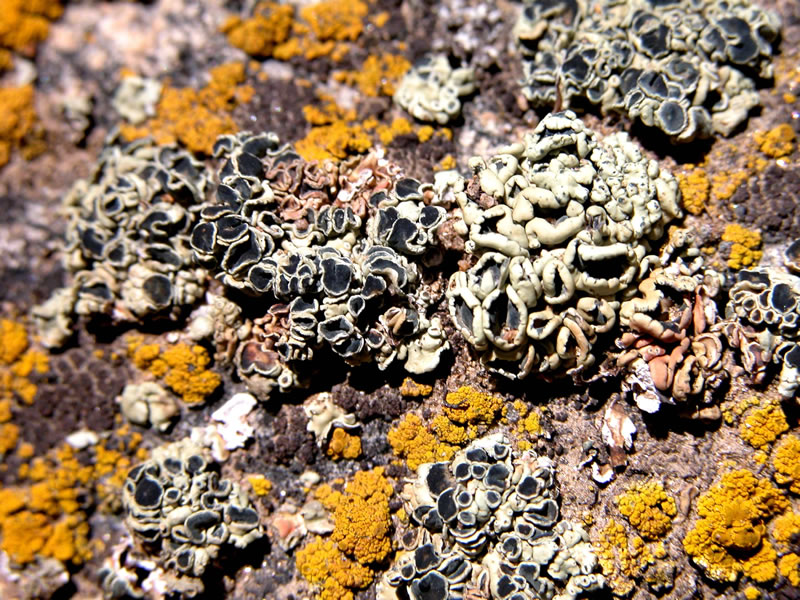Lichen Biology
Structure
Lichens do not have a waxy cuticle like plants have on their leaves, nor do they have vascular tissue such as xylem and phloem to move nutrients and water around their thalli as a plant does. Everything in the lichen’s environment is absorbed into the lichen's structure. Lichens get their water and nutrients from their surrounding environment via air and rain.
The general structure of a lichen is composed of layers of fungus and alga.
Cortex
The cortex is the outer layer of the lichen thallus. These cells are thicker and more closely packed than the other fungal cells in the lichen. This layer provides some small measure of protection, as well as provides color in some species.
Algal Layer
You can usually tell what kind of alga a lichen has just by color alone. When a lichen is dry, its color is usually gray or colored like the fungal cells on the upper cortex. When a lichen is wet, those cells become transparent, and the algal cells underneath get a chance to show their vibrancy.
Green algae generally give the lichen a bright green color when wet, although there are exceptions of pigmented lichens with green algae due to the fungal partner showing its colors.
Cyanobacteria can be a layer under the upper cortex or in tiny pockets on top of the upper cortex if there is a green algal layer already present. Cyanobacteria will give the lichen a dark green, brown, or black color.
In some lichens, however, there are no layers of fungus and alga. The individual components are mixed together in one big uniform layer and the resulting growth form is gelatinous. These types of lichens are called jelly lichens.
 Lobaria oregana with L. pulmonaria growing in the middle. These species are good examples of green algae showing through the fungal partner and giving the thalli a green color. Photo by Karen Dillman, U.S. Forest Service.
Lobaria oregana with L. pulmonaria growing in the middle. These species are good examples of green algae showing through the fungal partner and giving the thalli a green color. Photo by Karen Dillman, U.S. Forest Service.
Medulla
The majority of the lichen thallus is comprised of fungal filaments called the medulla. It is made of fungal cells that are loosely packed in the middle of the lichen thallus, have thin cell walls, and are threadlike. The result is a cotton-like substance underneath the outer cortex.
Basal Attachment
Lichens attach to their substrate by different means.
Rhizines are fungal filaments that extend from the medulla and attach the lichen to its substrate. Rhizines have no vascular capabilities like the roots in plants. They do not move water or nutrients to the lichen; they simply hold the lichen down to whatever it is sitting on.
Holdfast is an extension of the lichen thallus. Instead of many rhizines, some lichens have a central peg or holdfast that attach to the substrate, generally a rock. These types of foliose lichens are called umbilicate lichens, since the central holdfast is like an umbilical cord.
Growth Forms
There are three main types of lichens:
- Foliose
- Fruticose
- Crustose
Foliose Lichens
Foliose lichens have two easily distinguishable sides. In other words, there is a top side and there is a bottom side. They can be very flat, leafy like lettuce, or convoluted and full of ridges and bumps.
Fruticose Lichens
Fruticose lichens can be pendant and hair-like, upright and shrubby, or upright and cup-like. Many fruticose lichens have round branches that have a central core and others are hollow in the middle. Other fruticose lichens have flat branches that tangle up with each other.
 Cladonia fimbriata, trumpet lichen. Notice the cup-like stalks. Photo by Charles Peirce, Michigan Wildflowers.
Cladonia fimbriata, trumpet lichen. Notice the cup-like stalks. Photo by Charles Peirce, Michigan Wildflowers.
 Usnea longissima, old man’s beard. This rare lichen hangs from a central stalk and can get up to several feet in length. Its habitat is shrinking and instead of establishing itself via spores, parts of it break off and reestablish elsewhere. It is a strong indicator species of air pollution. Photo by Karen Dillman, U.S. Forest Service.
Usnea longissima, old man’s beard. This rare lichen hangs from a central stalk and can get up to several feet in length. Its habitat is shrinking and instead of establishing itself via spores, parts of it break off and reestablish elsewhere. It is a strong indicator species of air pollution. Photo by Karen Dillman, U.S. Forest Service.
Crustose Lichens
Crustose lichens are just that, crusts. They form a crust over a surface, like a boulder, the soil, a car, or your roof shingles. They can come in many bright, vibrant colors like sunny yellow, orange, and red, as well as grays and greens. Crustose lichens are pressed against their substrate.
Reproduction
Can you imagine how two different species living in the same body reproduce? We know that to reproduce, we need to have two of the same species to produce fertile offspring. Lichens are unique in that they are composed of two (or more) different species, or in fact, kingdoms.
Lichens are different. Unlike plants that can produce seeds that grow into new plants, lichens do not have a straightforward way to grow more lichen. Since the fungus is the dominant partner in the relationship, it gets to develop its fruiting bodies and produce spores. These spores can produce another fungus, but unfortunately, for the alga, it does not get the opportunity to reproduce at all. Either the new fungus has to find an algal partner or it perishes.
Of course, evolution must go on, and lichens have adapted to their bi-specific struggle. These organisms can vegetatively reproduce; that is, they have structures specifically developed for the spread of fragments of their thalli, with both partners. Not only are there specific vegetative structures, but simple fragments of lichen can grow into full-size thalli.












